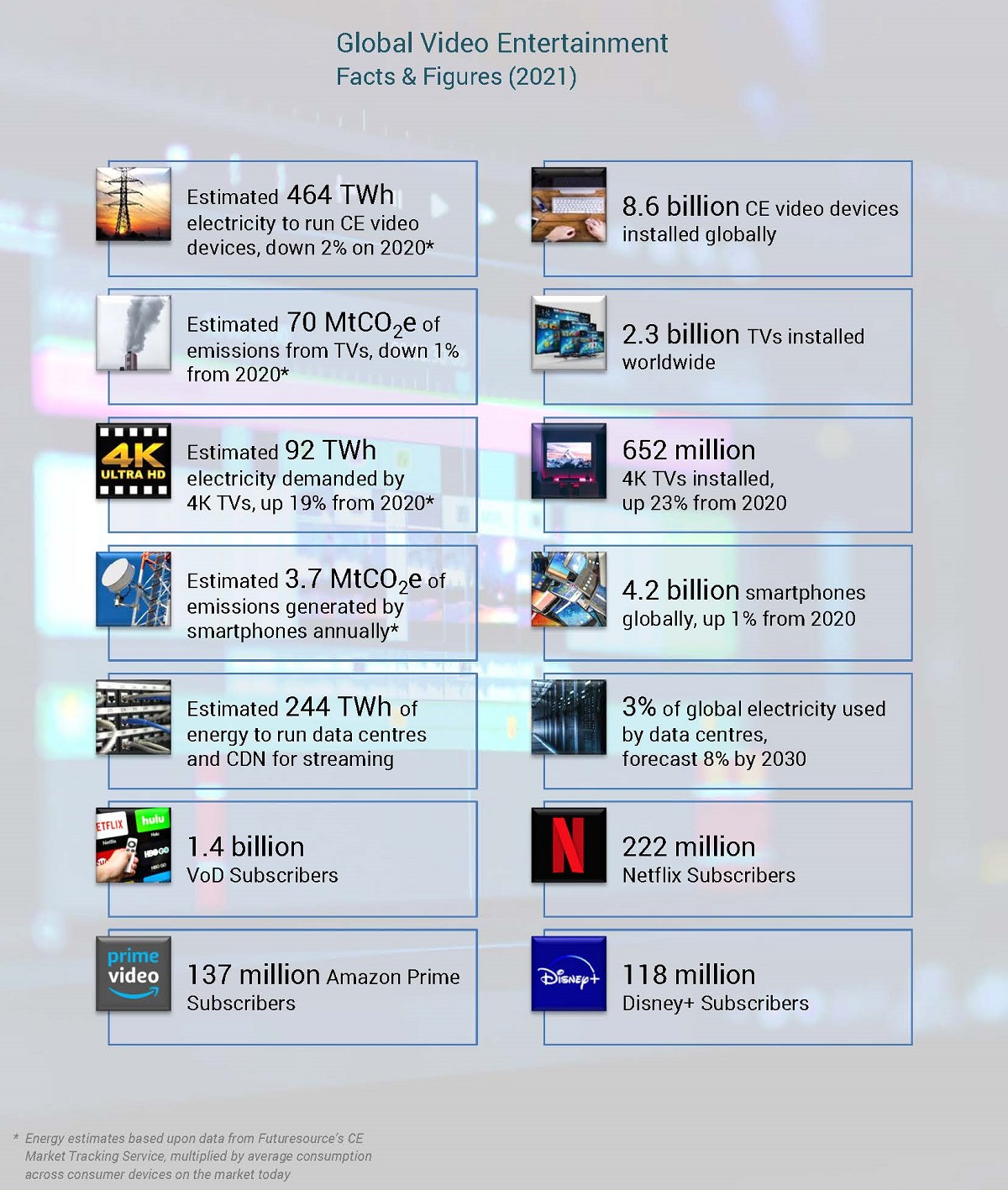
TL;DR
- As the carbon footprint of the video entertainment industry has ballooned to exceed even that of the airline industry, what will it take to make sustainability a key element of video content creation?
- Progress is steady but there remains an absence of common sustainability metrics to measure energy consumption end-to-end.
- Televisions are the most energy intensive entertainment products, and the migration to higher spec and larger screens is undermining any gains in “green tech” as 4K HDR becomes the new baseline for video.
READ MORE: Sustainability in Video Entertainment (Interdigital)
The chief culprit of carbon emissions is widely thought to be the airline industry but a new white paper suggests that global video entertainment is actually worse for the planet.
An average day of filming generates more than one person’s annual carbon footprint, claims a new whitepaper investigating sustainability in video entertainment. An average hour filming is equivalent to the carbon footprint of a return flight from London to New York, it reveals.
The white paper, “Sustainability in Video Entertainment,” released by InterDigital and written by Futuresource Consulting, explores the reasons why the video entertainment industry must lead on positive climate action, set higher standards when it comes to energy efficiency, and integrate solutions that mitigate energy consumption across the video chain.
The carbon footprint for production is immense. Even medium-sized films have an average carbon footprint of 769 metric tons of CO2e, with large films generating creating 1,081 metric tons per production.
In addition to reducing material waste and promoting recycling on set, there are many more approaches that film production can adopt to make the process more sustainable.
Accurate measurement of one’s carbon footprint is a crucial component and certification from BAFTA’s Albert, EcoProd’s Carbon Clap initiative, the Production Guild of America, and the Digital Production Partnership (DPP), among others, helps encourage people in the video industry to make a positive change. However, the reports notes, there are still no standardized measurement, which creates difficulties in creating a holistic approach to calculate carbon emissions across the industry overall.
Another way of cutting down on production carbon output is to use virtual production. One study quoted in the paper discovered that filming vehicle shoots in virtual production could reduce CO2 emissions by between 85% and 90% compared to conventional filming.
The move towards more sustainable film and TV production has accelerated a transition to cloud-native workflows. That’s an improvement since cloud technology consumes 20% of the energy footprint of on-premises data centers if running the same workload, per the report.

Live broadcasting has made efforts to become more sustainable — such as remote working — but more needs to be done. The highly expensive carbon footprints of OB trucks can be offset if the industry moves towards more modular solutions. This means provisioning only the equipment needed for specific broadcasts, reducing energy needed for transporting and generating it all onsite.
OB trucks can also achieve greater flexibility by using IP networks, by using electricity or biofuels, rechargeable battery units or simply being EVs.
However, it is the delivery/consumption component of video entertainment that seems to burn the most energy.
More than a billion hours of content is consumed on a single streaming platform every single day, the white paper states, and as a consequence the video streaming industry’s annual carbon footprint now exceeds that of the airline industry.
Meanwhile, global TV energy usage alone could increase 5% by 2026 as consumers upgrade to higher resolution screens and transition to 4K HDR video.
According to the white paper, the carbon footprint of streaming video depends heavily on how data centers source their electricity, and how efficiently they run servers and networking equipment, which in turn contributes toward CO2 emissions.
“With more investment in renewable energy to power data centers, the environmental impact of video streaming isn’t growing as fast as it was previously,” says Simon Forrest, principal technology analyst at Futuresource Consulting. “However, more must be done; it is increasingly likely that the efficiency gains of current technologies may be unable to keep pace with growing data demand. To reduce the risk of rising energy use and emissions, investments in efficient next-generation computing and communications technologies are needed, alongside continued efforts to decarbonize the electricity supply.”
The paper contends that energy-aware streaming protocols promise more than 50% in energy savings per hour of content.
VISIT OUR DEDICATED SUSTAINABILITY MICROSITE.




